lock HONDA ELEMENT 2007 1.G Workshop Manual
[x] Cancel search | Manufacturer: HONDA, Model Year: 2007, Model line: ELEMENT, Model: HONDA ELEMENT 2007 1.GPages: 275, PDF Size: 4.16 MB
Page 163 of 275

Constant application of the brakes
when going down a long hill builds
up heat and reduces their ef f ective-
ness. Use the engine to assist the
brakes by taking your f oot of f the
accelerator and downshif ting to a
lower gear.The hydraulic system that operates
the brakes has two separate circuits.
Each circuit works diagonally across
the vehicle (the lef t-f ront brake is
connected with the right-rear brake,
etc.). If one circuit should develop a
problem, you will still have braking
at two wheels.
Resting your f oot on the pedal keeps
the brakes applied lightly, builds up
heat, and reduces their ef f ectiveness.
It also keeps your brake lights on all
the time, conf using drivers behind
you. Your vehicle is equipped with disc
brakes at all f our wheels. A power
assist helps reduce the ef f ort needed
on the brake pedal. The anti-lock
brake system (ABS) helps you retain
steering control when braking very
hard.
Check your brakes af ter driving
through deep water. Apply the
brakes moderately to see if they f eel
normal. If not, apply them gently and
f requently until they do. Be extra
cautious and alert in your driving.Braking System Design
Braking System
160
Page 164 of 275

If the brake pads need replacing, you
will hear a distinctive, metallic
screeching sound when you apply
the brake pedal. If you do not have
the brake pads replaced, they will
screech all the time. It is normal f or
the brakes to occasionally squeal or
squeak when you apply them.The anti-lock brake system (ABS)
helps prevent the brakes f rom
locking up, and helps you retain
steering control by pumping the
brakes rapidly, much f aster than a
person can do it.
The ABS also balances the f ront-to-
rear braking distribution according
to vehicle loading.
Let the ABS work f or you by always
keeping f irm, steady pressure on the
brake pedal. This is sometimes
ref erred to as ‘‘stomp and steer.’’You will f eel a pulsation in the brake
pedal when the ABS activates, and
you may hear some noise. This is
normal: it is the ABS rapidly
pumpingthebrakes.Ondry
pavement, you will need to press on
thebrakepedalveryhardbeforethe
ABS activates. However, you may
feel the ABS activate immediately if
you are trying to stop on snow or ice.
You should never pump the brake pedal.
Brake Wear Indicators
Anti-lock Brakes
Braking System, Anti-lock Brakes (ABS)
Driving
161
Page 165 of 275

If this indicator comes on, the anti-
lock function of the braking system
has shut down. The brakes still work
like a conven tional system, but
without anti-lock. You should have
your dealer inspect your vehic le as
soon as possible.
If the indicator comes on while
driving, test the brakes as instructed
on page .
If the ABS indicator and the brake
system indicator come on together
and the parking brake is fully
released, the front-to-rear braking
distribution system may also shut
down. Test
your brakes as instructed on
page . If the brakes f eel normal,
drive slowly and have your vehicle
repaired by your dealer as soon as
possible. Avoid sudden hard braking
which could cause the rear wheels to
lock up and possibly lead to a loss of
control.
The VSA indicator will come on
alongwiththeABSindicator.
It only helps with steering
control during braking. such as trying to take a
corner too f ast or making a sudden
lane change. Always drive at a safe
speed f or the road and weather
conditions.
Always steer moderately
when you are braking hard. Severe
or sharp steering wheel movement
can still cause your vehicle to veer
into oncoming traffic or off the road.
on loose or
uneven surf aces, such as gravel or
snow, than a vehicle without anti-
lock.
233
233
Anti-lock Brakes (ABS)
ABS Indicator
Important Saf ety Reminders
A BS does not reduce the time or
distance it takes to stop the
vehicle. A BS will not prevent a skid that
results f rom changing direction
abruptly,
A BS cannot prevent a loss of
stability.
A vehicle with A BS may require a
longer distance to stop
162
Page 177 of 275

Before you leave the pavement, be
sure to do all scheduled maintenance
and service, and inspect your vehicle
f or any problems. Pay special
attention to the condition of the tires,
and check the tire pressures.
After you return to the pavement,
caref ully inspect your vehicle to
make sure there is no damage that
could make driving it unsaf e.
Recheck the condition of the tires
and the tire pressures.
The route presents limits (too steep
or bumpy roads). You have limits
(driving skill and comfort). And your
vehicle has limits (traction, stability,
and power).
Driving of f -highway can be
hazardous if you f ail to recognize
limits and take the proper
precautions.Forbettertractiononallsurfaces,
accelerate slowly and gradually build
up speed. If you try to start too fast
on wet soil, mud, snow, or ice, you
might not have enough traction to
get underway, and you may dig
yourself a hole. Starting with the
shif t lever in second (2) gear will
help you have a smoother start on
snow or ice.
Keep in mind that you will usually
need more time and distance to
brake to a stop on unpaved surf aces.
Avoid hard braking. Do not ‘‘pump’’
the brakes; let the anti-lock braking
system pump them f or you.
Debris in the road can damage your
suspension or other components.
Because your vehicle has a high
center of gravity, driving over a large
obstacle, or allowing a wheel to drop
into a deep hole can cause your
vehicle to tip or roll over.
If you can’t clearly see all conditions
or obstacles on a slope, walk the
slope bef ore you drive on it. If you
have any doubt whether or not you
can saf ely drive on the slope, don’t
do it. Find another route.
If you are driving up a hill and f ind
that you cannot continue,
. Your vehicle could roll
over. Slowly back down the hill,
f ollowing the same route you took up
the hill.
do not try to
turn around
Of f -Highway Driving Guidelines
Check Out Your Vehicle
Remember A ccelerating and Braking A voiding Obstacles
Driving on Slopes
174
Page 194 of 275
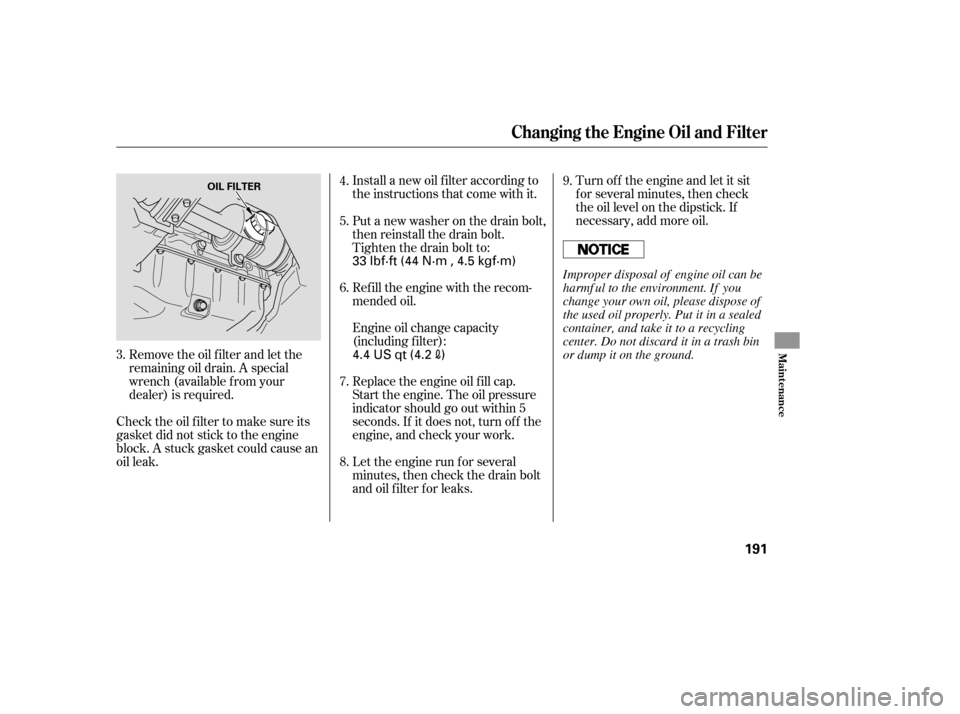
Remove the oil f ilter and let the
remaining oil drain. A special
wrench (available from your
dealer) is required.Install a new oil f ilter according to
the instructions that come with it.
Turn of f the engine and let it sit
f or several minutes, then check
the oil level on the dipstick. If
necessary, add more oil.
Let the engine run f or several
minutes, then check the drain bolt
and oil f ilter f or leaks. Replace the engine oil f ill cap.
Start the engine. The oil pressure
indicator should go out within 5
seconds. If it does not, turn of f the
engine, and check your work. Refill the engine with the recom-
mended oil.
Engine oil change capacity
(including f ilter): Put a new washer on the drain bolt,
then reinstall the drain bolt.
Tighten the drain bolt to:
Check the oil f ilter to make sure its
gasket did not stick to the engine
block. A stuck gasket could cause an
oil leak. 4.
3. 5.
6.
7.
8.9.
Changing the Engine Oil and Filter
Maint enance
191
OIL FILTER
4.4 US qt (4.2)
33 lbf·ft (44 N·m , 4.5 kgf·m)
Improper disposal of engine oil can be
harmf ul to the environment. If you
change your own oil, please dispose of
the used oil properly. Put it in a sealed
container, and take it to a recycling
center. Do not discard it in a trash bin
or dump it on the ground.
Page 196 of 275
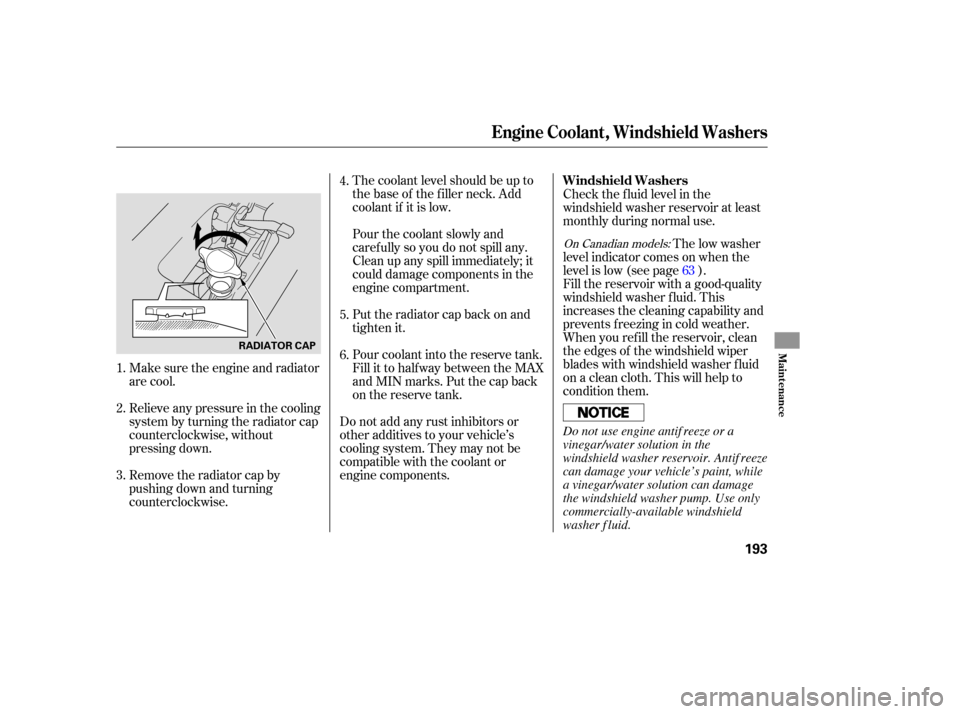
The coolant level should be up to
the base of the filler neck. Add
coolant if it is low.
Pourthecoolantslowlyand
carefully so you do not spill any.
Clean up any spill imme diately; it
could damage componen ts in the
engine compartm ent.
Put the radiator cap back on and
tighten it.
Pour coolant into the reserve tank.
Fill it to halfway between the MAX
and MIN marks. Put the cap back
on the reserve tank.
Do not add any rust inhibitors or
other additives to your vehicle’s
cooling system. They may not be
compatible with the coolant or
engine components. Fill
the reservoir with a good-quality
windshield washer fluid. This
increases the cleaning capability and
prevents freezing in cold weather.
Check
the fluid level in the
windshield washer reservoir at least
monthly during normal use.
The low washer
level indicator comes on when the
level is low (see page ).
When you ref ill the reservoir, clean
the edges of the windshield wiper
blades with windshield washer f luid
on a clean cloth. This will help to
condition them.
Remove the radiator cap by
pushing down and turning
counterclockwise. Make sure the engine and radiator
are cool.
Relieve any pressure in the cooling
system by turning the radiator cap
counterclockwise, without
pressing down. 4.
5.
2. 1.
3. 6.
63
On Canadian models:
Windshield Washers
Engine Coolant, Windshield Washers
Maint enance
193
RADIATOR CAP
Do not use engine antif reeze or a
vinegar/water solution in the
windshield washer reservoir. Antif reeze
can damage your vehicle’s paint, while
a vinegar/water solution can damage
the windshield washer pump. Use only
commercially-available windshield
washer f luid.
Page 200 of 275

A low power steering f luid level can
indicate a leak in the system. Check
the f luid level f requently, and have
the system inspected as soon as
possible.
To clean the gray composite body
panels, wash them with soap and
water only. Do not apply wax to the
panels; it will cause discoloration. Always use Honda Power Steering
Fluid. You may use another power
steering f luid as an emergency
replacement, but have the power
steering system f lushed and ref illed
with Honda PSF as soon as possible.
Check the level on the side of the
reservoir when the engine is cold.
The f luid should be between the
UPPER LEVEL and LOWER LEVEL.
If not, add power steering f luid to the
UPPER LEVEL.
Pour the f luid slowly and caref ully so
you do not spill any. Clean up any
spill immediately; it could damage
components in the engine
compartment.
The f luid level should be between
theMINandMAXmarksontheside
of the reservoir. If it is not, add
brake f luid to bring it up to that level.
Use the same fluid specified for the
brake system.
A low f luid level can indicate a leak
in the clutch system. Have this
system inspected as soon as possible.
If equipped with body panels
Manual Transmission only
Cleaning the Body Panels
Power Steering Fluid
Clutch Fluid
Brake and Clutch Fluid, Power Steering Fluid, Cleaning the Body Panels
Maint enance
197
UPPER LEVEL
LOWER LEVEL
MAX
MAX
Turning the steering wheel to f ull lef t
or right lock and holding it there can
damage the power steering pump.
Page 203 of 275
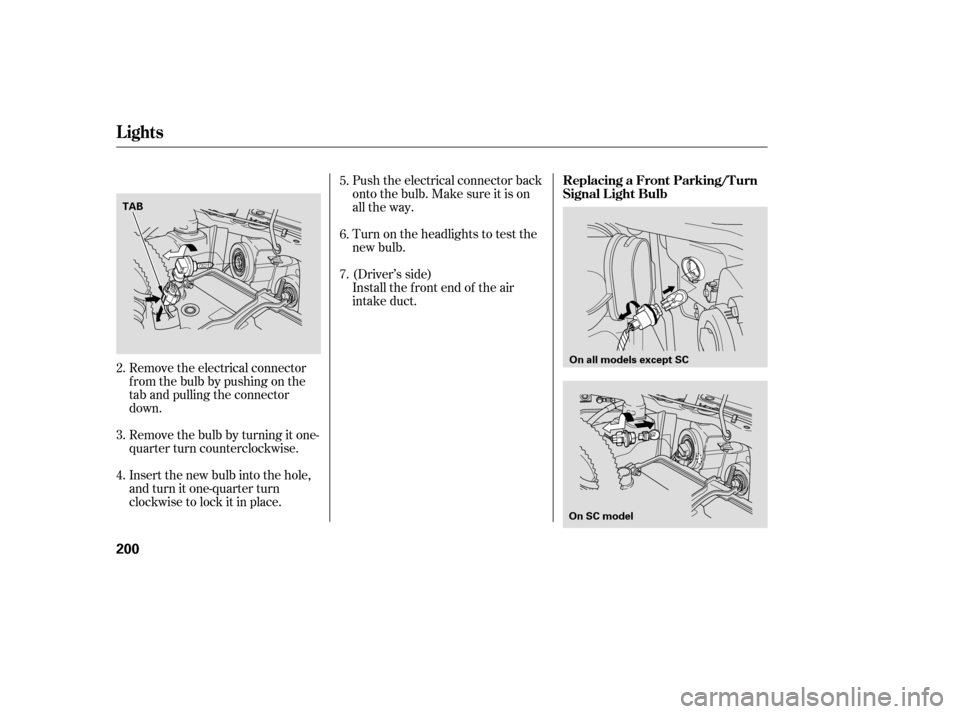
Push the electrical connector back
onto the bulb. Make sure it is on
all the way.
Turn on the headlights to test the
new bulb.
(Driver’s side)
Install the f ront end of the air
intake duct.
Insert the new bulb into the hole,
and turn it one-quarter turn
clockwise to lock it in place. Remove the bulb by turning it one-
quarter turn counterclockwise. Remove the electrical connector
f rom the bulb by pushing on the
tab and pulling the connector
down.
3.
4. 5.
6.
7.
2.
Lights
Replacing a Front Parking/Turn
Signal Light Bulb
200
On all models except SC
On SC model
TAB
Page 204 of 275
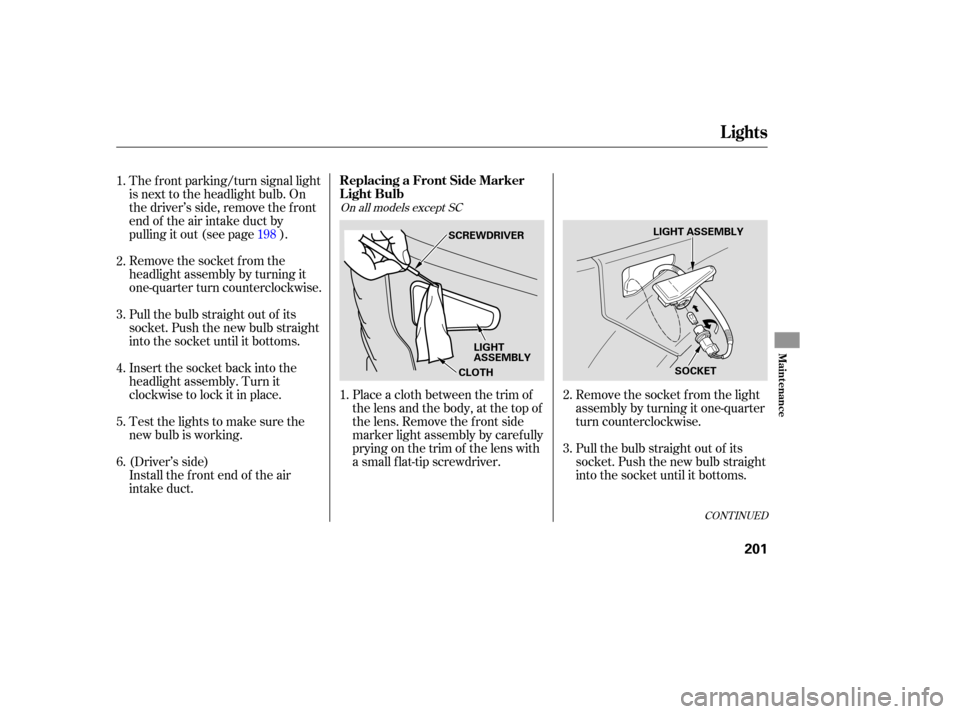
Remove the socket from the light
assembly by turning it one-quarter
turn counterclockwise.
Pull the bulb straight out of its
socket. Push the new bulb straight
into the socket until it bottoms.
Place
a cloth between the trim of
the lens and the body, at the top of
the lens. Remove the front side
marker light assembly by carefully
prying on the trim of the lens with
a small flat-tip screwdriver.
The
front parking/turn signal light
is next to the headlight bulb. On
the driver’s side, remove the front
end of the air intake duct by
pulling it out (see page ).
Remove the socket from the
headlight assembly by turning it
one-quarter turn counterclockwise.
Pull the bulb straight out of its
socket. Push the new bulb straight
into the socket until it bottoms.
Insert the socket back into the
headlight assembly. Turn it
clockwise to lock it in place.
Testthelightstomakesurethe
new bulb is working.
Install the f ront end of the air
intake duct. 1.
2.
3.
1.
2.
3.
4.
5.
6.
198
(Driver’s side)
CONT INUED
On all models except SC
Lights
Replacing a Front Side Marker
Light Bulb
Maint enance
201
SCREWDRIVER CLOTH LIGHT
ASSEMBLY LIGHT ASSEMBLY
SOCKET
Page 205 of 275
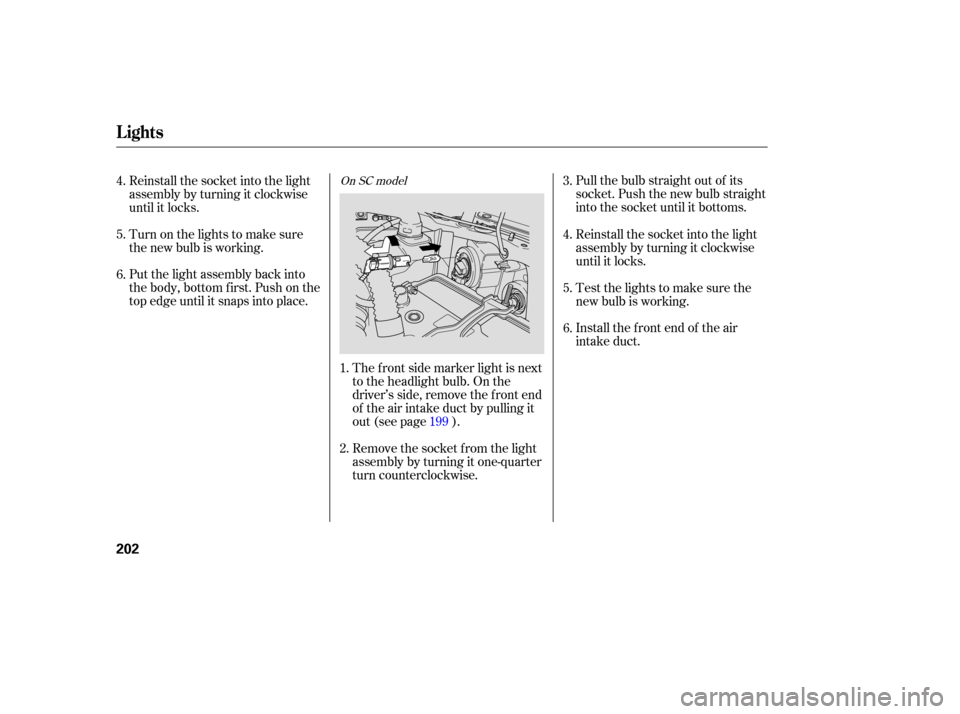
Pull the bulb straight out of its
socket. Push the new bulb straight
into the socket until it bottoms.
The front side marker light is next
to the headlight bulb. On the
driver’s side, remove the front end
of the air intake duct by pulling it
out (see page ).
Reinstall the socket into the light
assembly by turning it clockwise
until it locks.
Turn on the lights to make sure
the new bulb is working.
Put the light assembly back into
the body, bottom first. Push on the
top edge until it snaps into place.
Remove the socket f rom the light
assembly by turning it one-quarter
turn counterclockwise.Testthelightstomakesurethe
new bulb is working.
Install the f ront end of the air
intake duct. Reinstall the socket into the light
assembly by turning it clockwise
until it locks.
1. 3.
2. 4.
5.
6.
4.
5.
6.
199On SC model
Lights
202